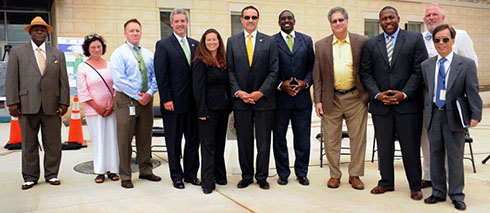
 FOR IMMEDIATE RELEASE: July 24, 2013
FOR IMMEDIATE RELEASE: July 24, 2013
Doxie McCoy (EOM) 202.727.9691; [email protected]
Darrell S. Pressley (DGS) 202.997.9017; [email protected]
(Washington D.C.) - (WASHINGTON, D.C.) – Mayor Vincent C. Gray was joined today by representatives from the Chesapeake Bay Trust and U.S. Environmental Protection Agency (EPA) in announcing $400,000 in funding to seven municipalities and nonprofit organizations through the Green Streets, Green Jobs, Green Towns (G3) initiative. The District of Columbia received one of the awards - a $95,000 grant to support stormwater management and green street development along a new section of O Street NW, adjacent to the site of the brand-new Dunbar Senior High School.
“Not only am I proud to announce this green street project will be built next to my alma mater’s new campus, but I also welcome the opportunity we have as a District to help improve local and downstream environmental conditions in the Chesapeake Bay,” said Mayor Gray. “From a single 1.2-inch rainfall, this project will capture more than 39,000 gallons of stormwater runoff. That means 39,000 gallons of untreated stormwater will be kept out of our local water bodies.”
The project along O Street will include the installation of 6,125 square feet of bioretention cells that will collect stormwater from the school and surrounding area. It supports the Mayor’s Sustainable DC initiative to make the District the nation’s greenest, healthiest, most sustainable city.
Jointly funded by the Chesapeake Bay Trust and the EPA, G3 supports green-infrastructure projects that improve water quality, community livability and economic vitality throughout the region. Today’s grantees and their projects were unveiled at the press event.
“Local governments around the country are seeing the benefits of utilizing green infrastructure for controlling stormwater,” said EPA Regional Administrator Shawn M. Garvin. “G3 grantees are leading the way – providing valuable examples to others on the road to creating sustainable communities and healthy watersheds.”
G3 was created in 2011 to support projects that reduce stormwater runoff through the creation of “green streets.” A green street is one that minimizes the environmental impact of a roadway by practices such as reducing the amount of water that is piped directly into streams and rivers; rain gardens; installing new street trees; using energy-efficient lighting; and encouraging pedestrian and bicycle access. Green streets also provide aesthetic and economic benefits.
With construction of the new Dunbar Senior High School, the District’s Department of General Services (DGS) realized there was a unique opportunity to reopen O Street NW with the addition of aggressive stormwater management. DGS approached The District Department of the Environment (DDOE) in the fall of 2012 about making the section of O Street a green street and partnered to install bioretention cells as a means for retaining 1.2” of runoff from a 1.2-acre drainage area.
“DGS is excited to be a part of the G3 initiative, because it will not only help us to reopen O Street as a green street and enhance the modernization of Dunbar High School, but it will also help to protect our environment by reducing the amount of rain and precipitation that goes into the District's sewer and stormwater treatment system,” said DGS Director Brian J. Hanlon.
The O Street project will also involve newly planted trees in large tree boxes, built on a neighborhood street, where the stormwater will be collected and will help to avoid sewer backups. Other green elements of the new Dunbar include the use of a geothermal heat pump, a 500,000-kW photovoltaic array, two 20,000-gallon cisterns for reusing rainwater, enhanced acoustics, and materials with low concentrations of volatile organic compounds and plentiful daylight and views.
The G3 effort was developed under the President’s Chesapeake Bay Executive Order to provide assistance to communities in urbanized watersheds for reducing stormwater runoff, improving energy conservation, promoting livable communities, and creating green jobs.
“The Chesapeake Bay Trust is pleased to partner with EPA to promote green infrastructure practices that not only improve water quality, but also positively benefit local communities,” said Chesapeake Bay Trust Executive Director Jana Davis. “Our goal is to leverage ‘gray’ infrastructure projects that a community already plans to undertake, such as roadway reengineering. By adding the green component during the construction process, it minimizes costs while improving results.”
The other six G3 grants announced at the press briefing were awarded to projects in Cambridge and Prince George’s County, Md.; Northumberland County, Pa.; and Richmond, Va. Those projects are designed to improve water quality, increase energy efficiency and promote environmental best practices.
The G3 grant program is open to local governments and non-profit organizations interested in pursuing urban green stormwater infrastructure and green jobs as part of an overall integrated community or watershed plan.
###
Follow DGS on Facebook and Twitter!
Follow DGS on Twitter at http://www.twitter.com/DCDGS and on Facebook at http://www.facebook.com/DCDGS.
